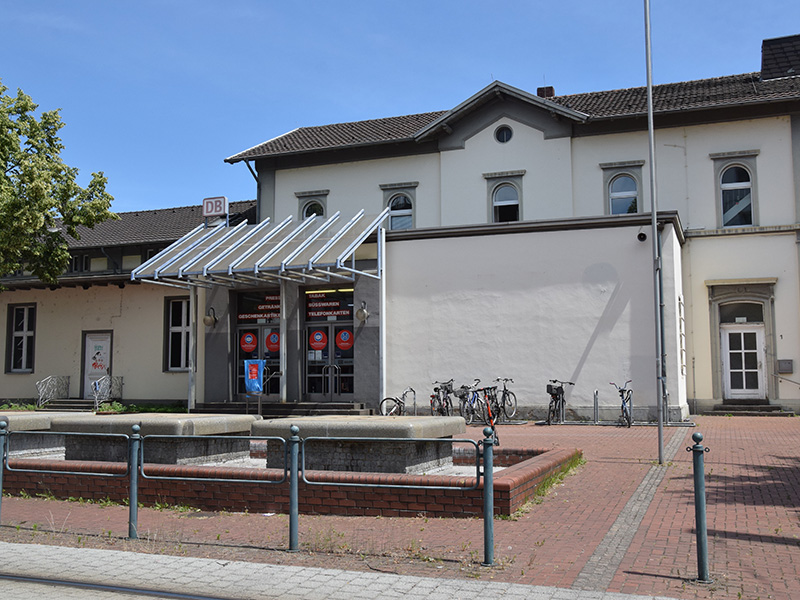11. Projekte Tour: Beueler Bahnhof
HISTORISCHE INFORMATIONEN ZUM BEUELER BAHNHOF
Auf dieser Seite erhalten Sie weiterführende Informationen zum Beueler Bahnhof vom Denkmal- und Geschichtsverein Bonn-Rechtsrheinisch e.V.
Der Beueler Bahnhof
Der unter Denkmalschutz stehende Güterbahnhof in Bonn-Beuel aus den 1870er Jahren befindet sich in einem einmaligen Erhaltungszustand: So sind die umfangreichen Gleisanlagen und die Ladestraße bis heute nicht nur einsatzfähig, sondern auch in Betrieb. Besonders selten ist die Tatsache, dass der Güterschuppen nach wie vor über sein Zufahrtsgleis angefahren werden kann. Das Gesamtensemble ist jedoch durch den geplanten Bau einer neuen S-Bahnlinie gefährdet.
Lage und Architektur
Der Güterbahnhof Bonn-Beuel wurde in den 1870er Jahren von der Rheinischen Eisenbahn-Gesellschaft an der Rechten Rheinstrecke zwischen Köln und Koblenz gegenüber dem Empfangsgebäude für den Personenverkehr errichtet. Das Gelände erstreckt sich relativ schmal aber sehr lang zwischen der Bahnlinie und der Königswinterer Straße.
Neben mehreren Lager- und Verwaltungsgebäuden und einem historischen Güterschuppen mit Laderampen umfasst das Güterbahnhofsgelände zahlreiche Neben-, Abstell- und Ladegleise sowie eine Ladestraße. Der Güterschuppen ist ein langgestreckter mit Ziegelsteinen ausgemauerter Fachwerkbau. Er wurde von einem freien Architekten geplant und unterscheidet sich signifikant von anderen Güterschuppen im Rheinland, die nach der Verstaatlichung der Eisenbahn im Jahr 1880 alle nach preußischer Norm gebaut worden waren.
Beuel entwickelt sich zum Industriestandort
Durch die Inbetriebnahme des Güterbahnhofs in den 1870er Jahren entwickelte sich das zuvor eher ländlich geprägte Beuel zu einem prosperierenden und wohlhabenden Industriestandort. Die Aufteilung der Beueler Bahnhofsanlage mit dem Empfangsgebäude auf der westlichen und der Güteranlage auf der östlichen Seite der Gleise teilte die Umgebung in ein bürgerliches Viertel mit teils prächtiger Wohnbebauung und ein industriell geprägtes Viertel mit Arbeitersiedlungen. Diese Aufteilung bestimmt bis heute das Beueler Stadtbild, so dass die Bahnhofsanlage siedlungsgeschichtlich den historischen Kern des modernen Beuel darstellt.
In Bahnhofsnähe siedelten sich zahlreiche Fabriken an, von denen viele ab 1900 mittels der Industriebahn Beuel-Großenbusch direkt mit dem Güterbahnhof verbunden waren. Vom Güterbahnhof wurden aber auch direkte Gleisverbindungen zu unmittelbar angrenzenden Fabriken, wie zum Beispiel der chemischen Fabrik L.C. Marquart OHG, angelegt.
Noch vor dem Ersten Weltkrieg wurde das Güterbahnhofsgebäude stark erweitert, damit der immense Warenumschlag abgefertigt werden konnte. Um die Verladung über Kopf- und Seitenrampen sowie über die Ladestraße direkt zu gewährleisten, entstanden zahlreiche Neben-, Abstell- und Ladegleise.
Der Beueler Güterbahnhof im Zweiten Weltkrieg
Im Zweiten Weltkrieg waren die Beueler Industrie und insbesondere der Güterbahnhof Ziel von Luftangriffen. Im Petroleumkeller des zentralen Güterbahnhofsgebäudes wurde eine aufwändige Luftschutzanlage mit Schleuse installiert, die den Bahnarbeitern Schutz bot. Die Reichsbahnstrecke und das Empfangsgebäude im Personenbahnhof wurden bei Bombenangriffen schwer getroffen, das Verwaltungsgebäude und der Lokschuppen der Industriebahn Beuel-Großenbusch vollständig zerstört. Der historische Güterschuppen hingegen blieb von Kriegsschäden nahezu verschont. Die Luftschutzanlage unter dem Güterbahnhofsgebäude wurde erst im Jahr 1958 zurückgebaut; die Stahltüren und Beschriftungen sind jedoch bis heute weitgehend erhalten.
Bedeutungsverlust
Ab Anfang der 1960er Jahre sank in Beuel der Güterumschlag auf den Gleisen. 1965 stellte die Industriebahn den Betrieb mit eigenen Lokomotiven ein; daraufhin bediente die Bundesbahn die Gleise der Industriebahn noch bis 1994 mit einer Kleinlok. Um 1997 wurde die Stückgutverladung in Beuel aufgegeben und damit das Güterbahnhofsgebäude funktionslos. Kurz darauf endete mit der Stilllegung des Gleisanschlusses zum Marquardt-Chemiewerk der Güterumschlag im Bahnhof Beuel. Das bis dahin komplett erhaltene und kaum veränderte Gelände des Güterbahnhofs war somit dem Verfall preisgegeben.
Revitalisierung
Ende 1999 vermietete die Deutsche Bahn AG das zentrale Güterbahnhofsgebäude an einen Großhandelsbetrieb für Oldtimerersatzteile, dessen Geschäftsleitung den brachliegenden, zum Gebäude gehörenden Gleisanschluss für die Belieferung mit Überseecontainern wieder aktivieren wollte. Diese äußerst ungewöhnliche Umkehr der allgemeinen Entwicklung wurde gegen zahlreiche Widerstände nach zwei Jahren realisiert und der lokale Cargo-Umschlag im Güterbahnhof damit wieder aufgenommen. Zwischenzeitlich etablierte sich auch auf der Industriebahn im kleinen Umfang wieder Güterverkehr unter der Regie der Rhein-Sieg-Eisenbahn GmbH (RSE), welche bis heute einen Teil des Güterbahnhofsgeländes nutzt.
Während zwischen 1995 und 2010 alle anderen Güterbahnhöfe in der Region Bonn / Rhein-Sieg betrieblich geschlossen und letztendlich abgerissen wurden, blieb die Beueler Anlage durch die initiale Aktivität des Oldtimerteile-Großhandels und der neuen Führung der Industriebahn vorerst vom Verfall und Rückbau verschont. Dadurch konzentrierte sich der verbliebene lokale Schienengüterverkehr automatisch auf Beuel. Auch andere Betriebe begannen nun abermals in Beuel zu verladen. Holz, Stahl, Autos, Containerfrachten und Baumaterialen werden seitdem wieder in Beuel umgeschlagen. Inzwischen nutzt sogar die Deutsche Bahn AG die Anlage als Logistikzentrum für Instandhaltungsmaßnahmen an der Rechten Rheinstrecke.
2004 erwarb der Lidl-Konzern weite Teile des Güterbahnhofsgeländes, um dort einen Discountmarkt zu eröffnen. Es folgte ein jahrelanger erbitterter Kampf der Güterbahnhofsbefürworter gegen die Lidl-Baupläne. 2011 gab Lidl den Kampf schließlich auf und veräußerte das Gelände zurück an die Deutsche Bahn, ein bundesweit wohl einmaliger Vorgang.
Kulturhistorische Beudeutung
Historisch interessant ist die Tatsache, dass sich der Beueler Güterbahnhof heute in einem einmaligen Erhaltungszustand präsentiert. So sind die umfangreichen Gleisanlagen (unter anderem mit Kopf- und Seitenrampen) für den lokalen Güterverkehr nicht nur fast vollständig erhalten und einsatzfähig, sondern immer noch in Betrieb und zusätzlich über die Ladestraße erreichbar. Besonders selten ist die Tatsache, dass der Güterschuppen nach wie vor über sein Zufahrtsgleis angefahren werden kann. Aus diesen Gründen steht nicht nur der Güterschuppen, sondern die gesamte Güterverkehrsanlage seit 2009 unter Denkmalschutz.
Pläne zum Bau der S-Bahnlinie S 13
Derzeit existieren Pläne zum Bau einer umstrittenen neuen S-Bahnlinie S 13 zwischen Troisdorf und Bonn-Oberkassel, die den einmaligen Erhaltungszustand der Gesamtanlage unwiderruflich zerstören würden. Denn für den neuen Haltepunkt in Bonn-Beuel müsste die historische Ladestraße weitgehend verschwinden und alle Gleisanlagen und Rampen des Güterbahnhofs abgebaut werden. Zwar soll das zentrale Güterbahnhofsgebäude nach derzeitigem Planungsstand transloziert und knapp zwei Meter weiter östlich wieder errichtet werden, jedoch wäre ein lokaler Schienengüterverkehr oder gar eine Verlademöglichkeit im Rahmen der historischen Anlage dann nach über 140 Jahren endgültig Geschichte. Damit würde ein bundesweit einzigartiges Denkmalensemble verloren gehen.
Baudenkmal
Das Objekt „Güterbahnhof Beuel“ ist Bestandteil des eingetragenes Baudenkmals „Bahnhofsgebäude Bahnhof Bonn-Beuel“ (LVR-Amt für Denkmalpflege im Rheinland, Nr. 29949 / Denkmalliste der Stadt Bonn, laufende Nr. A 3191).
(Florian Kalff und Anne Stollenwerk, Rheinischer Verein für Denkmalpflege und Landschaftsschutz e.V., 2014, mit freundlicher Unterstützung der Nordrhein-Westfalen-Stiftung Naturschutz, Heimat und Kulturpflege)
Quelle: Kuladig
